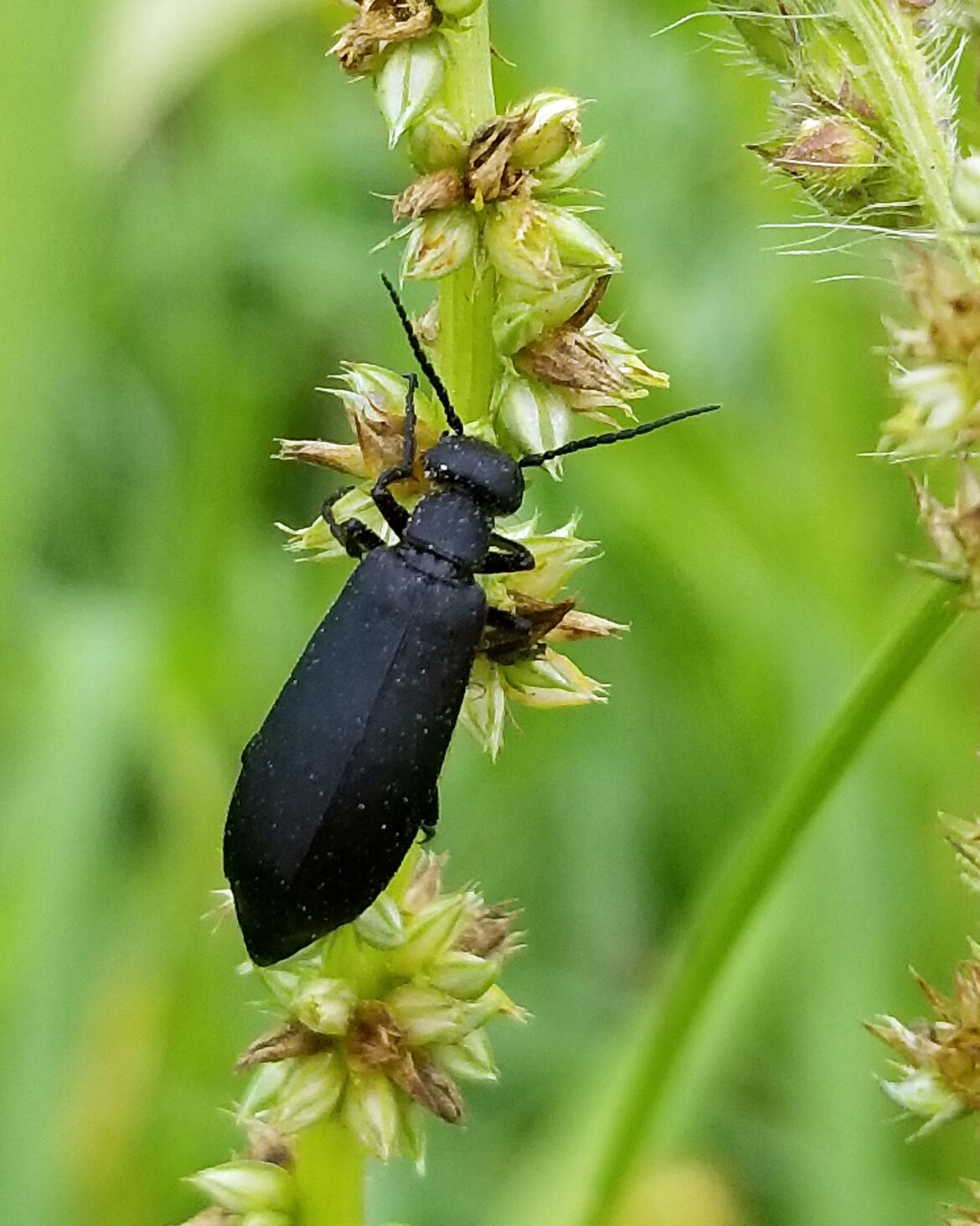Blister beetles have made their appearance in North Dakota and are feeding on alfalfa fields.
“The name ‘blister beetle’ stems from a naturally occurring toxin called cantharidin produced by the beetle that causes blistering of skin when the beetle is crushed and the toxin is released,” says James Rogers, Extension forage crops production specialist at North Dakota State University’s North Central Research Extension Center.
Adult blister beetles are attracted to blooming alfalfa fields and weeds (goldenrods, dandelions). They will feed on nectar and pollen and devour leaves, stems and flowers. Blister beetles produce one generation per year and will be active from June to September. Adult blister beetles will lay their eggs in soil from late summer to early fall and can overwinter in North Dakota as larvae, emerging in mid to early summer.
Cantharidin from blister beetles can cause severe inflammation and even death in horses, says Rogers. In horses, depression, inflammation and ulceration of the mouth, irritation of the gastrointestinal tract, and painful urination are common symptoms of sub-lethal doses of cantharidin. Cattle and sheep are much more tolerant of cantharidin ingestion. Little work has been done to establish toxicity levels, though symptoms can occur with cantharidin ingestion. These symptoms may include depression, elevated temperatures and dehydration.
The most common species of blister beetles found in North Dakota are the ash-gray and black blister beetle. Lesser seen are the striped and Nuttall’s blister beetle. Blister beetle toxicity levels are higher in males but also vary by species and by the region in which the beetles are found, says Rogers. Adults range in size from ½ inch to 1 inch long. Blister beetles are fairly easy to identify among other beetles, as the “neck” region located behind the head is narrower than the head when viewed from above.
Blister beetles are very mobile and tend to swarm in large numbers in small areas of the field, says Miranda Meehan, NDSU Extension livestock environmental stewardship specialist. They can move into alfalfa fields from field edges that have a host plant such as sweet clover, which blooms earlier than alfalfa. Once alfalfa begins to bloom, they may move into a field and feed for a short period of time before migrating to other areas of the field or to new fields. After alfalfa is cut, they often move into blooming canola and other blooming field crops. Hay infested with blister beetles is a big concern for hay producers and livestock owners.
Here are some ways to reduce the threat of blister beetles:
- Use equipment such as a disc mower without hay conditioners or crimpers that may crush blister beetles and release toxin into the hay. This also encourages beetles to move out of the hay field.
- Allow cut hay to fully dry before raking to allow beetles to move out of the hay. Raking may dislodge dead beetles from hay; however, the potential still exists for cantharidin in the hay.
- Control blooming weed hosts near or in alfalfa fields.
- Cut alfalfa at less than 10% bloom and/or late in the season (mid-August to early September).
- Check fields 24 hours prior to cutting to ensure that new swarms of blister beetles have not re-infested the fields.
- Scout harvested hay and underneath windrows closely for blister beetles and allow blister beetles to move out of drying hay before baling. Turning the windrows may be helpful to get blister beetles to move out.
“Even tractor tires can crush blister beetles in hay when turning equipment around,” says Karl Hoppe, Extension livestock systems specialist at NDSU’s Carrington Research Extension Center. “Cut hay with a sickle bar or disc mower that allows blister beetles to move out of hay after cutting. If large numbers of blister beetles are observed in spots during harvesting, it is best to quit harvesting and allow blister beetles to move out of the way or go around them.”
If blister beetles are suspected in harvested hay, do not feed it to horses. If alfalfa is fed to horses and symptoms such as blood-tinged urine, depression or placing their muzzle in water without drinking appear, call a veterinarian immediately. Hay contaminated with blister beetles can be used by cattle, but be cautious. Offer other hay sources that are clean of blister beetles or blend hays. Grinding hay containing blister beetles and then mixing with other feeds will dilute the cantharidin but won’t get rid of it. If feed refusal is noted with cattle offered alfalfa hay, then remove it and replace with another hay source. Keep track of bales that are suspected to have blister beetle contamination so you can manage accordingly and avoid accidental feeding to horses.
It can be difficult to detect blister beetles in harvested hay because beetles may be crushed from the haying process. Blister beetles may not be present in every bale due to the insects’ tendency to swarm, which means that it is possible that only bales from certain areas of the field may be infested. Chemical control is generally not recommended at harvest because dead beetles could be still be incorporated into cured hay instead of falling onto the ground.
If blister beetle toxicity is suspected, a diagnostic test is available through the NDSU veterinary diagnostic laboratory. Plasma or urine samples are used for the test. For more information about the test, visit ndsu.ag/VDL-sample. Additional information on blister beetle identification and management is available at ndsu.ag/blister-beetle. NDSU Extension agents are also available to aid in identification and determine best management practices for dealing with blister beetles.
###
NDSU Extension


